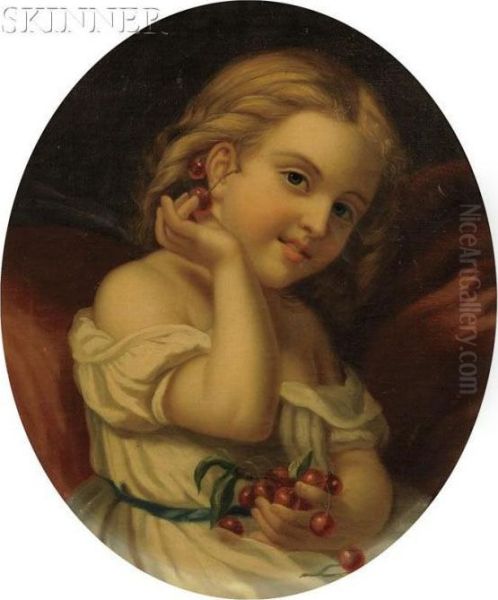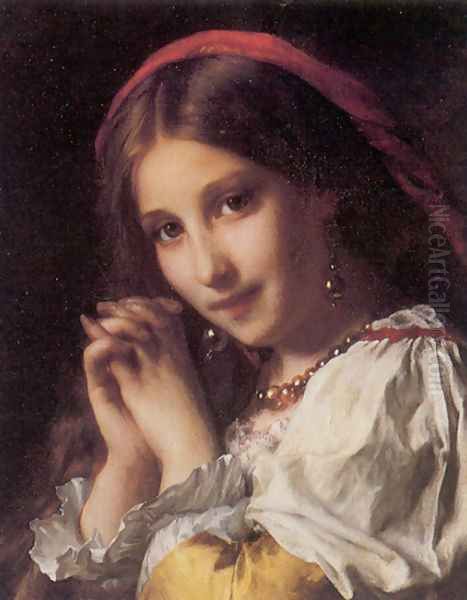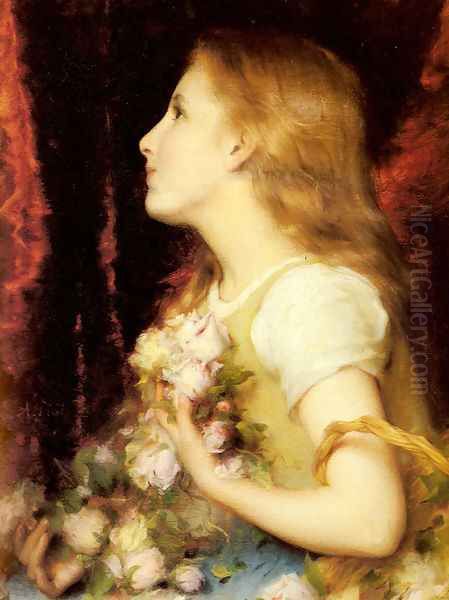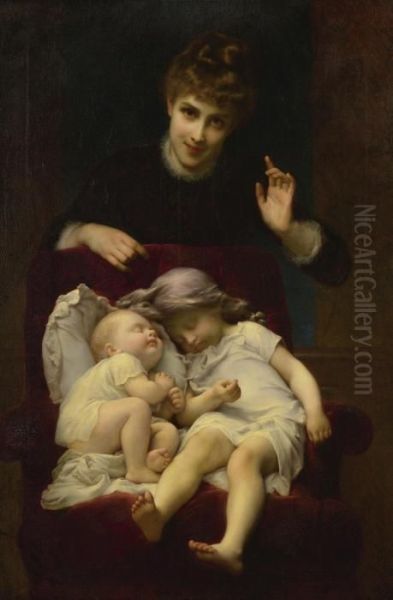Étienne Adolphe Piot stands as a significant figure in late 19th and early 20th-century French art, celebrated primarily for his sensitive and elegant portrayals of young women. Working within the Academic tradition, Piot carved a distinct niche for himself, capturing the idealized femininity and refined sensibilities of the Belle Époque. While perhaps not as revolutionary as some of his contemporaries who embraced Impressionism or Post-Impressionism, Piot's dedication to craft, his understanding of his clientele, and his ability to imbue his subjects with a gentle charm earned him considerable success and a lasting place in the annals of French portraiture. His life, spanning from a period of artistic transition to the dawn of modernism, offers insight into the enduring appeal of traditional aesthetics even amidst radical change.
Early Life and Artistic Formation
The precise details of Piot's earliest years have occasionally been subject to minor discrepancies in historical records, with some older sources suggesting a birth year in the 1820s. However, the most reliable and widely accepted evidence points to his birth on February 13, 1831, in the town of Digoin, located in the Saône-et-Loire department of Burgundy, France. Like many aspiring artists of his generation, Piot recognized that Paris was the epicenter of the art world, offering unparalleled opportunities for training and exhibition. He eventually made his way to the capital to pursue his artistic education.
Crucially, Piot became a student of Léon Cogniet (1794-1880), a highly respected painter and influential teacher. Cogniet himself was a product of the Neoclassical school, having studied under Pierre-Narcisse Guérin, yet his work evolved to incorporate elements of Romanticism. He was known for historical paintings, portraits, and later, for his role as a prominent instructor at the École des Beaux-Arts and in his private studio. Studying under Cogniet provided Piot with a rigorous foundation in drawing, composition, and the traditional techniques valued by the French Academy.
The Influence of Léon Cogniet

Léon Cogniet's tutelage was formative for Piot. Cogniet was a figure who bridged the gap between the strict Neoclassicism of Jacques-Louis David and the burgeoning Romantic movement. His own works, such as "Marius among the Ruins of Carthage" or his sensitive portraits, demonstrated technical mastery combined with emotional depth. As a teacher, he imparted the importance of anatomical accuracy, meticulous draughtsmanship, and a well-structured composition – hallmarks of the Academic style.
Cogniet's studio was a significant training ground for numerous artists who would achieve prominence. Besides Piot, his pupils included figures like Léon Bonnat, known for his powerful portraits, and Jean-Louis-Ernest Meissonier, famed for his incredibly detailed historical and military scenes. This environment exposed Piot to high standards of technical execution and the prevailing artistic currents favored by the official art establishment. Cogniet's emphasis on capturing likeness while adhering to classical ideals undoubtedly shaped Piot's approach to portraiture.
Debut and Ascent at the Paris Salon
The Paris Salon, the official art exhibition of the Académie des Beaux-Arts, was the paramount venue for artists seeking recognition and patronage in 19th-century France. Acceptance into the Salon was a crucial step in establishing a career, offering exposure to critics, dealers, and potential clients. Étienne Adolphe Piot made his debut at this prestigious exhibition in 1850, marking the formal beginning of his public career.
From this point forward, Piot became a regular exhibitor at the Salon for several decades. Consistent participation was key to maintaining visibility and building a reputation. His chosen subjects, primarily graceful portraits of women and occasionally genre scenes, found favor with the Salon juries and the public. While the Salon system faced increasing challenges from independent exhibitions later in the century, particularly from the Impressionists, it remained the dominant force for much of Piot's active career, and his success within this system was vital to his professional standing. His works were noted for their charm and technical polish, aligning well with the tastes of the Salon-going audience.
Artistic Style: Academicism and Refined Portraiture
Étienne Adolphe Piot worked firmly within the Academic style that dominated official French art for much of the 19th century. This tradition emphasized adherence to established rules of composition, idealized forms, meticulous finish (known as fini), and the primacy of drawing (dessin) over more expressive use of color (coloris). Subjects drawn from history, mythology, religion, and portraiture were highly valued. Piot embraced these tenets, focusing his considerable skill on creating portraits and genre scenes that were both technically accomplished and aesthetically pleasing according to prevailing standards.

His specialization became the portrayal of young women. Piot's female subjects are typically depicted with a sense of grace, innocence, and quiet contemplation. He excelled at rendering the soft textures of skin, the intricate details of fashionable attire, and the play of light on surfaces. His brushwork is generally smooth and controlled, avoiding the visible, broken strokes characteristic of the Impressionists like Claude Monet or Berthe Morisot. Instead, Piot aimed for a seamless finish that enhanced the idealized beauty of his sitters.
While adhering to Academic principles, Piot's work often possesses a gentle, sometimes sentimental or dreamy quality. He employed soft lighting and harmonious color palettes, frequently using chiaroscuro (the contrast of light and dark) in a subtle manner to model form and create atmosphere, rather than for dramatic effect. His portraits, though often idealized, convey a sense of individual personality and inner life, distinguishing them from mere decorative images. He captured fleeting expressions and thoughtful gazes, adding a layer of emotional resonance to his technically polished works.
Representative Works and Thematic Focus
Several paintings exemplify Piot's style and thematic preoccupations. Works titled Portrait of a Young Girl appear frequently in his oeuvre, showcasing his consistent focus. These often feature head-and-shoulders or half-length views, allowing him to concentrate on the sitter's face and expression. The backgrounds are typically simple and dark, ensuring the viewer's attention remains fixed on the subject.
Portrait of a Girl with Red Shawl is a notable example highlighting his skill with color and texture. The vibrant red of the shawl contrasts effectively with the sitter's pale skin and dark background, demonstrating his controlled use of a strong accent color. The rendering of the fabric's texture and the soft modeling of the girl's features are characteristic of his refined technique.
Young Girl with a Basket of Flowers introduces a common motif associated with youth, beauty, and nature. Such works blend portraiture with genre elements, creating a charming narrative. The inclusion of flowers adds decorative appeal and symbolic potential, often relating to innocence or burgeoning womanhood. Similarly, The Reading Girl depicts a popular 19th-century theme, suggesting leisure, education, and introspection. These images contributed to contemporary ideals of refined femininity.
A work like Motherhood shows Piot exploring themes beyond youthful beauty, touching upon familial bonds and tenderness, albeit still rendered with his characteristic grace and polish. Origami Dreams, depicting a young girl absorbed in the delicate task of paper folding, exemplifies his ability to capture quiet moments of concentration and imbue genre scenes with intimacy and charm through careful observation and skillful light handling.
Commercial Success in the Belle Époque

Piot's artistic career coincided significantly with the Belle Époque (roughly 1871-1914), a period of relative peace, prosperity, and cultural dynamism in France, particularly in Paris. The burgeoning upper-middle class (bourgeoisie) experienced increased wealth and leisure, fostering a strong market for art, especially portraiture. Portraits served not only as personal mementos but also as status symbols, displayed prominently in affluent homes.
Piot's style was perfectly attuned to the tastes of this clientele. His elegant, idealized, yet recognizable depictions of young women appealed to families seeking flattering representations of their daughters or wives. It's noted that during this era, a portrait by a recognized artist was almost a prerequisite for a fashionable bride. Piot capitalized on this demand, becoming a sought-after portraitist among the Parisian elite. His work avoided the controversial subject matter or techniques of the avant-garde, offering instead reassuring beauty and technical refinement that aligned with conservative aesthetic values. This commercial success provided him with financial stability and solidified his position within the mainstream art world.
International Exposure
While Piot's primary sphere of activity was Paris and the Salon, his reputation extended beyond French borders. Evidence of this includes his participation in exhibitions abroad, which helped to broaden his recognition and potential market. As early as 1860, his work was shown at an exhibition in Bordeaux, a major French city but outside the immediate Parisian center.
More significantly, he gained exposure in the Anglophone world. In 1864, he exhibited a portrait at the prestigious National Academy of Design in New York City. This indicates an effort to reach American patrons, who were becoming increasingly important collectors of European art during this period. Three years later, in 1867, his work was also shown in London. These international exhibitions, though perhaps less frequent than his Salon appearances, demonstrate that Piot's appealing style found resonance with audiences and collectors outside of France, contributing to his overall professional stature.
Academic Recognition and Affiliations
Beyond his success at the Salon and with private clients, Piot received official recognition from the established art institutions of his time. In 1883, he became a member of the Société des Artistes Français. This organization was formed after the French government relinquished direct control of the annual Salon, and it became one of the primary bodies managing the official exhibition. Membership signified acceptance and standing within the mainstream artistic community.

Further validating his position, Piot received an Honorable Mention at the Exposition Universelle held in Paris in 1889 (some sources cite 1890, but 1889 is more commonly associated with awards from that specific World's Fair). These large-scale international exhibitions were major cultural events, and receiving any award amidst the vast number of works displayed was a significant achievement. These accolades confirmed his status as a respected artist working within the accepted Academic framework, recognized by his peers and the official art hierarchy.
Piot in the Context of 19th-Century French Art
To fully appreciate Étienne Adolphe Piot's place in art history, it's essential to view him within the rich and complex tapestry of 19th-century French painting. He operated squarely within the Academic tradition, upholding the values instilled by his teacher, Léon Cogniet. His focus on idealized female beauty and technical polish aligns him with other highly successful Salon painters like William-Adolphe Bouguereau and Alexandre Cabanel, both masters of the smooth finish and mythological or gracefully rendered figurative subjects that dominated the official exhibitions for decades.
In the specific realm of portraiture, Piot's elegant style can be compared to several contemporaries, though with distinct nuances. His work shares a certain refinement with the courtly portraits of Franz Xaver Winterhalter (active earlier but influential), though Piot's subjects are generally less aristocratic and perhaps more intimate. Compared to the fashionable society portraits of Carolus-Duran or the dazzlingly flamboyant works of Giovanni Boldini, Piot's style appears more reserved and gentle. He captured a quieter elegance, perhaps closer in spirit, though different in technique, to some of the society portraits by James Tissot.
Piot's dedication to traditional techniques contrasts sharply with the revolutionary movements emerging during his lifetime. The Impressionists, including Claude Monet, Pierre-Auguste Renoir (who also painted charming portraits but with a radically different, looser technique and brighter palette), Edgar Degas, and Berthe Morisot, challenged the very foundations of Academic art with their focus on capturing fleeting moments, the effects of light and color, and scenes of modern life, often using visible brushstrokes and unconventional compositions.
Later, the Post-Impressionists like Georges Seurat with his pointillist technique, or Paul Cézanne with his structural analysis of form, pushed artistic boundaries even further. Piot remained largely untouched by these avant-garde developments, continuing to practice the style that had brought him success. His contemporaries also included masters of other Academic genres, such as the meticulous historical painter Jean-Léon Gérôme and the aforementioned Ernest Meissonier. Piot's career thus exemplifies the persistence and popularity of Academic painting even as modern art was being born.
Later Career and Legacy

Étienne Adolphe Piot continued to work and exhibit into the later years of the 19th century and the very beginning of the 20th. Records indicate his participation in the Salon exhibitions possibly extended until 1899 or perhaps even as late as 1909, although the frequency may have diminished in his final years. He lived through a period of immense artistic change, witnessing the rise and evolution of Impressionism, Post-Impressionism, Fauvism, and the beginnings of Cubism, yet he remained faithful to his established Academic style.
Piot passed away in 1910, leaving behind a substantial body of work, primarily portraits that captured the specific aesthetic ideals of the Belle Époque. His paintings were acquired by museums, including the Musée des Beaux-Arts in Rouen and the Brooklyn Museum in New York, attesting to his recognition during his lifetime and shortly thereafter. While the advent of modernism led to a decline in the critical appreciation of Academic art for much of the 20th century, there has been a renewed interest in recent decades in understanding and re-evaluating the artists who worked within this tradition.
Piot's legacy lies in his skillful execution, his sensitive portrayal of feminine grace, and his role as a successful practitioner of a style that deeply resonated with the tastes of his time. His paintings offer valuable insights into the social and cultural milieu of late 19th-century Paris, preserving a vision of idealized beauty and elegance that defined an era. For collectors and enthusiasts of Academic art and Belle Époque portraiture, his work continues to hold considerable appeal.
Addressing Historical Uncertainties
As noted earlier, minor discrepancies exist in some historical accounts regarding Étienne Adolphe Piot's exact birth year. While the date of February 13, 1831, in Digoin is supported by official records and cited by major art historical resources like the Bénézit Dictionary of Artists, some earlier sources or auction records occasionally mention 1825 or the mid-1820s. This confusion is not uncommon for artists of this period before standardized record-keeping was universal. However, the weight of evidence strongly favors 1831. Similarly, the precise year of his final Salon exhibition (1899 or 1909) varies slightly in different accounts, possibly reflecting late entries or participation in different iterations of the Salon structure. These minor points do not detract from the overall understanding of his long and productive career.
Conclusion: An Enduring Vision of Elegance

Étienne Adolphe Piot (1831-1910) was a quintessential painter of the French Academic tradition, specializing in portraits that idealized the grace and beauty of young women during the Belle Époque. Trained by the esteemed Léon Cogniet, he mastered the techniques of his school, creating works characterized by meticulous finish, soft lighting, harmonious colors, and a gentle, often introspective mood. A regular exhibitor at the Paris Salon and recognized internationally, Piot achieved significant commercial success by catering to the tastes of the affluent Parisian society. While contemporary avant-garde movements revolutionized the art world, Piot remained a steadfast practitioner of the elegant, refined style that brought him renown. His works, found in museum collections and sought after by collectors, endure as charming testaments to the aesthetic sensibilities of his era and his considerable skill as a portraitist.